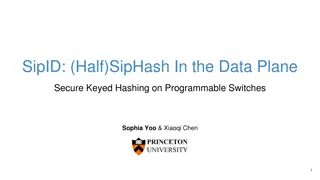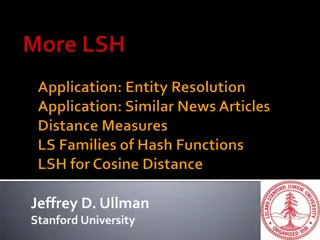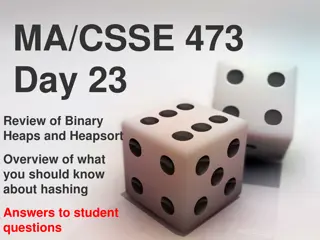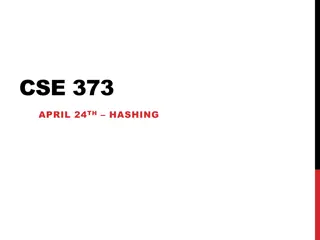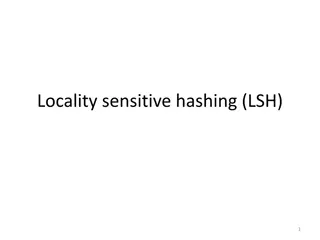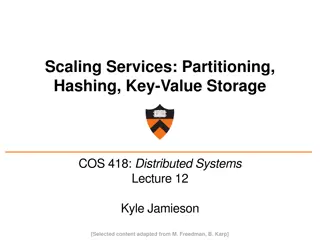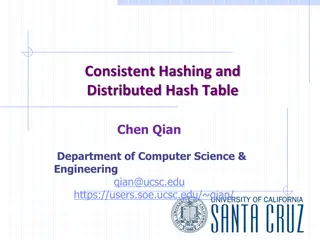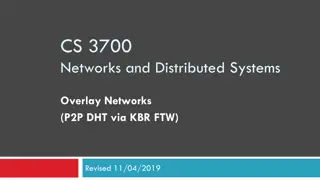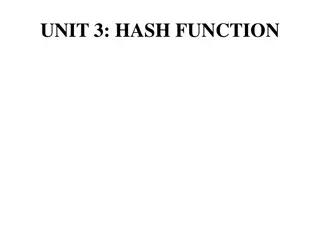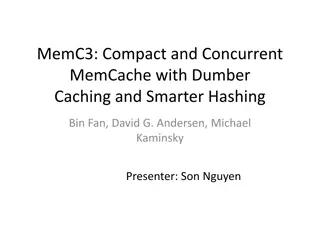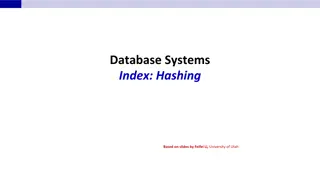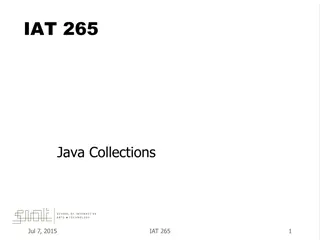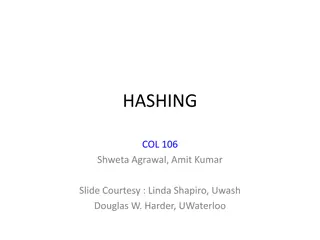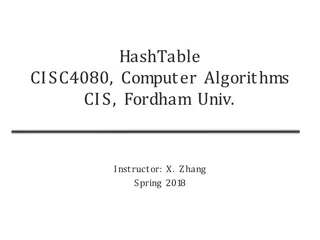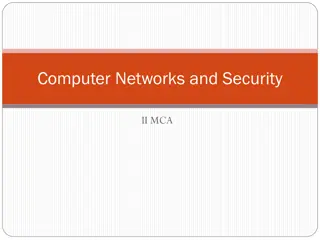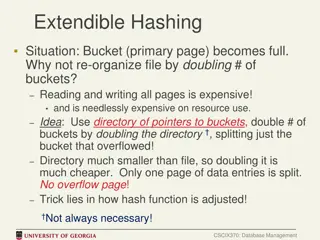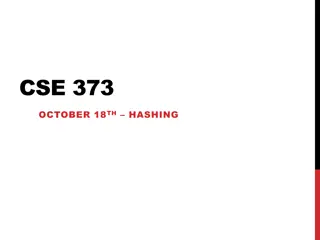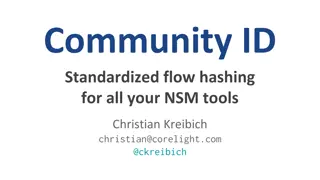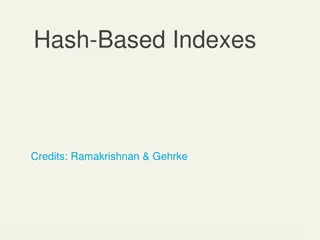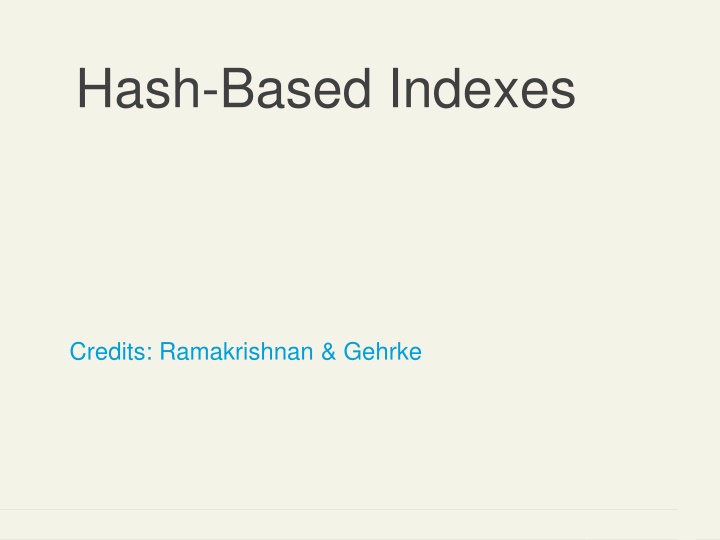
Hash-Based Indexes in Database Management
Explore the concept of hash-based indexes in database management, covering topics like static hashing, dynamic hash structure adjustment, extendible hashing, linear hashing, and when to choose B+trees vs. Hashing. Gain insights into the strengths and applications of different hashing techniques.
Uploaded on | 1 Views
Download Presentation

Please find below an Image/Link to download the presentation.
The content on the website is provided AS IS for your information and personal use only. It may not be sold, licensed, or shared on other websites without obtaining consent from the author. If you encounter any issues during the download, it is possible that the publisher has removed the file from their server.
You are allowed to download the files provided on this website for personal or commercial use, subject to the condition that they are used lawfully. All files are the property of their respective owners.
The content on the website is provided AS IS for your information and personal use only. It may not be sold, licensed, or shared on other websites without obtaining consent from the author.
E N D
Presentation Transcript
Hash-Based Indexes Credits: Ramakrishnan & Gehrke Textbook to be published by Pearson Ed in early 2014 CSCIX370: Database Management http://www.funwebdev.com
What you will learn from this lecture Review of static hashing How to adjust hash structure dynamically against inserts and deletes? Extendible hashing Linear hashing Relative strengths of B+trees and Hashing: when to use what CSCIX370: Database Management
Introduction Hash-based indexes are best for equality selections no traversal; direct computation of where k* should be cannot support range searches Static and dynamic hashing techniques exist; trade-offs similar to ISAM vs. B+ trees, on a certain level. CSCIX370: Database Management
Static Hashing # primary pages fixed, allocated sequentially, never de- allocated; overflow pages if needed. h(k) mod M = bucket to which data entry with key k (i.e., k*) belongs. (M = # of buckets) 0 h(key) mod M 1 key h M-1 Primary bucket pages Overflow pages CSCIX370: Database Management
Static Hashing (Contd.) Buckets contain data entries. Bucket size could be more than 1 block. Hash fn works on search key field of record r. Must distribute values over range 0 ... M-1. h(key) = (key mod M) usually works well for prime M. lots known about how to tune h. Long overflow chains can develop and degrade performance (when there are updates). Extendible and Linear Hashing: two major dynamic techniques to fix this problem. CSCIX370: Database Management
Extendible Hashing Situation: Bucket (primary page) becomes full. Why not re-organize file by doubling # of buckets? Reading and writing all pages is expensive! and is needlessly prodigal on resource use. Idea: Use directory of pointers to buckets, double # of buckets by doubling the directory , splitting just the bucket that overflowed! Directory much smaller than file, so doubling it is much cheaper. Only one page of data entries is split. No overflow page! Trick lies in how hash function is adjusted! Not always necessary! CSCIX370: Database Management
LOCAL DEPTH 2 Bucket A Example 4* 12* 32* 16* GLOBAL DEPTH 2 2 Bucket B 00 5* 1* 21* 13* Directory is array of size 4. To find bucket for r, take last `global depth # bits of h(r) e.g., h(r) = 5 = binary 101, it is in bucket pointed to by 01. hash fn used: h(k) = k (for illustration only). 01 2 10 Bucket C 10* 11 2 DIRECTORY Bucket D 15* 7* 19* DATA PAGES Insert: If bucket is full, split it (allocate new page, re-distribute data entries). E.g., consider insert 20* (10100). If necessary, double the directory. (As we will see, splitting a bucket does not always require doubling; we can tell by comparing global depth with local depth for the split bucket.) CSCIX370: Database Management
Example Remarks Depth deals with how many bits from the hash address suffix we examine at a given time. Global depth = what s the #bits needed to correctly find the home bucket for an arbitrary data entry, in general? Local depth of bkt B = how many bits did I really need to look at to get to bucket B? Global depth >= local depth. Check this on examples. Is this possible: GD > all LDs? CSCIX370: Database Management
Insert h(r)=20 - Part 1 Suppose h(k) = k for this example. Bucket A split into 2 using an extra bit, i.e., 3 bits A divisible by 8, i.e., 1000 A2 divisible by 4, i.e., 100 note that only one bucket needs to be re-distributed, i.e., re-hashed B, C, D remain unchanged Where to link A2? 2 LOCAL DEPTH Bucket A 32* 16* GLOBAL DEPTH 2 2 Bucket B 1* 5* 21*13* 00 01 10 11 2 Bucket C 10* 2 DIRECTORY Bucket D 15* 7* 19* 2 Bucket A2 (`split image' of Bucket A) 4* 12* 20* CSCIX370: Database Management
Insert h(r)=20 Part 2 3 LOCAL DEPTH double the directory add 1 to global depth & to local depth of A/A2. now can distinguish between A and A2 notice the difference in local depth between buckets multiple pointers to the same bucket Review properties of LD & GD. 32* 16* Bucket A GLOBAL DEPTH 2 3 1* 5* 21*13* 000 Bucket B 001 010 2 10* Bucket C 011 100 2 101 15* 7* 19* Bucket D 110 111 3 DIRECTORY 12* 20* Bucket A2 (`split image' of Bucket A) 4* Insert 9 (1001) now CSCIX370: Database Management
Points to Note 20 = binary 10100. Last 2 bits (00) tell us r belongs in A or A2. Last 3 bits needed to tell which. Global depth of directory: min # of bits needed to tell which bucket an entry belongs to = max{local depths}. Local depth of a bucket: # of bits used to determine if an entry belongs to this bucket. When does bucket split cause directory doubling? Before insert, local depth of bucket = global depth. Insert causes local depth to become > global depth; directory is doubled by copying it over and `fixing pointer to split image page. (Use of least significant bits enables efficient doubling via copying of directory!) CSCIX370: Database Management
Comments on Extendible Hashing If directory fits in memory, equality search answered with one disk access; else two. 100MB file, 100 bytes/rec, 4K page; contains 1,000,000 records (as data entries); 40 records/page 106/40 = 25,000 pages of data entries; as many directory elements; can handle using 15bit addresses; chances are high that directory will fit in memory. Directory grows in spurts, and, if the distribution of hash values is skewed, directory can grow large. Delete: If removal of data entry makes bucket empty, check to see whether all `split images can be merged if each directory element points to the same bucket as its split image, can halve directory rarely done in practice (e.g., leave room for future insertions). CSCIX370: Database Management

